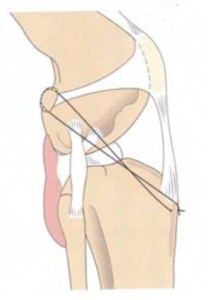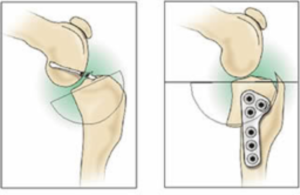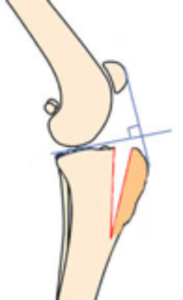Cranial Cruciate Ligament
Background
The cranial cruciate ligament (CCL) in dogs is the same ligament that is referred to as the anterior cruciate ligament (ACL) in people. (Although properly called the CCL you may see it called the ACL in some articles.) Dogs have similar anatomy to humans with their front legs (like our arms) having wrists, elbows, and shoulders and their back legs (like our legs) having ankles, knees, and hips. Inside the knee there are two ligaments that cross each other to make an “X”. These are the cranial and caudal cruciate ligaments. Injuries to the cranial cruciate ligament are exceedingly common in dogs, and with the occasional exception of some toy breeds, these injuries should be treated surgically. Two other important structures in the knee are the medial and lateral meniscus. Injury to the back part of the medial meniscus is commonly seen with CCL injuries and is treated at the same time as part of the CCL repair procedure.
Symptoms
A dog that has completely torn its CCL will initially hold up the injured leg and not bear any weight on it for several days. Often after a week or two, the dog might begin to put some weight back on the leg but will continue to have a noticeable limp. The diagnosis is usually made during the physical exam as the injured knee will have a characteristic instability in the knee called “drawer movement.”
Often, however, the CCL will be partially torn in which case the symptoms are less obvious and the diagnosis becomes more challenging. These dogs will usually have a slight limp but will still bear weight on the injured leg. The limp often goes away with rest but returns when the dog is exercised. They do not have “drawer movement” on physical exam. The diagnosis is usually made with a combination of symptoms, swelling of the knee and the characteristic changes seen on x-rays. From a surgical standpoint, a partial tear is treated exactly the same as a complete tear. This is because a partial tear of the CCL will not heal without surgery and will be a constant source of discomfort for the dog. Over time chronic inflammation caused by a partial CCL tear will cause significant arthritis in the knee.
Treatment Options
In people, the typical way to repair an injury to this ligament is by reconstructing the ligament with a type of graft. This approach has been tried in dogs but unfortunately has inconsistent results. In smaller and less active breeds a similar approach is used by stabilizing the joint with a type of suture material. This technique is referred to as an extra-capsular repair (figure 1). I have good success with this procedure in active dogs weighing less than 20 pounds and in less active dogs up to 40 pounds. In larger and more active dogs I recommend a tibial plateau leveling osteotomy (TPLO) or a tibial tubercle advancement (TTA) as these procedures are predictably more successful in these dogs.

The TPLO (figure 2) involves cutting the tibia near the knee joint. This is called an osteotomy. The cut portion of the bone near the knee joint is then rotated in a way that neutralizes the forces in the joint and functionally eliminates the drawer movement of the knee. The osteotomy is then secured with a bone plate and bone screws. When this is done the dog does not need to have the ligament replaced.

The TTA (figure 3) accomplishes the same force neutralization as does the TPLO but in a different way. In the TTA the bone behind the attachment of the patellar ligament (the ligament that extends from the kneecap to the tibia) is cut and advanced forward. It is held in place with titanium implants. Success is similar to the TPLO.

What to Expect After Surgery
Getting your dog home after surgery can be overwhelming. My main concerns are that your dog is comfortable and that ultimately the surgery will be successful and your dog will return to full athletic function. First, let me address your dog’s comfort level. All dogs receive an epidural of morphine prior to surgery. This will generally keep them comfortable throughout the first day and evening. They will then be switched to oral anti-inflammatory and pain medications as needed. With respect to the restrictions and ultimate success of the surgery there are really just two main rules to remember and follow:
- Do not let your dog lick at its incision. Licking is NEVER okay. Licking is bad for the incision and will prevent healing, or worse, cause the incision to open up and expose the surgery site to infection.
- Normal day-to-day activity in the house is permitted, including the use of the stairs as is necessary, although unnecessary trips up and down the stairs should be avoided when possible. However, when your dog is not in the house, for any reason, he/she MUST be kept on a short leash calmly walking by your side at ALL TIMES for the first 8 weeks. No doggie door.
- No letting him/her out in the backyard. No matter what time of day, no matter what the weather, he/she must be on a leash at all times when outside for 8 weeks. Every time your dog goes outside to urinate, defecate, or go for a walk, he/she must be on a leash and accompanied by a responsible person. The length of walks should be dictated by the dog’s comfort level. As he/she can tolerate, longer walks are permitted. If the dog tires or becomes more lame during or after the walk you probably went too far. That’s OK, just back off on the length a bit and build back up as the dog can tolerate.
Call us anytime, 24/7.
If you have concerns we are available to answer any questions you may have.